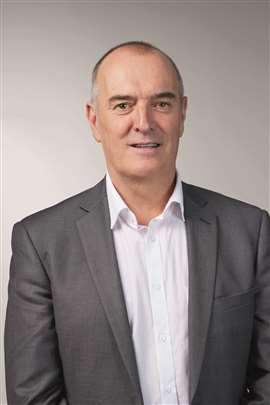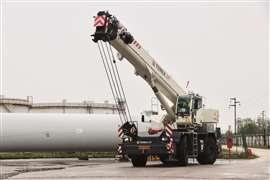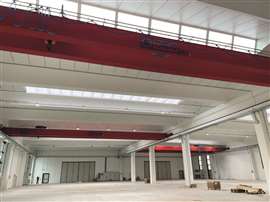INTERVIEW: Kieran Hegarty, Terex
29 January 2024
Kieran Hegarty, president at Terex Materials Processing (MP) which includes all the crane manufacturing, explains to Alex Dahm about the transformation of Terex cranes into two separate entities – what’s involved and what it means for buyers and users.
 Kieran Hegarty president at Terex Materials Processing (MP), the division that includes all the cranes. (Photo: Terex)
Kieran Hegarty president at Terex Materials Processing (MP), the division that includes all the cranes. (Photo: Terex)
Since the sale of Demag cranes in 2019, the remaining Terex crane brands were gathered together in the Terex MP business unit but that has now all changed.
A reorganisation has seen transformation of the tower crane and rough terrain businesses into two separate entities.
Now there are Terex Tower Cranes and Terex Rough Terrain Cranes, both of which sit in the Lifting category of Terex MP, itself part of Terex Corporation. The other cranes made by Terex are the Franna pick and carry type, built in Australia and India.
Changes include separate independent leadership and brand identities.
In the first of a series of articles Alex Dahm talked to Kieran Hegarty about the transformation and other news from the Terex Lifting businesses.
AD: What does the transformation of Terex Cranes into two separate entities mean for end users and buyers of cranes?
KH: First, the Terex cranes businesses that we have within Terex MP consists of what we call specialty lifting companies. We have what was Terex tower cranes, based in Fontanafredda in Italy. We also have Terex rough terrain cranes, based also in Italy, but in a different factory, in Crespellano. In addition, we also have Franna, an iconic pick and carry crane out of Australia.
Those are the three separate business units within Terex MP that serve the Lifting industry. Historically, when Terex had a full cranes division, everything from all terrain cranes through tower cranes, rough terrains, and Franna was run as a single business.
 Terex TRT 65 rough terrain crane manufactured in Crespellano, Italy. (Photo: Terex)
Terex TRT 65 rough terrain crane manufactured in Crespellano, Italy. (Photo: Terex)
Terex sold the all terrain and lattice boom cranes business to Tadano, which was the Demag business in Zweibrücken, Germany. We wanted to keep the rest of the lifting businesses fundamentally because they were good businesses and had been profitable over many years. However, tower cranes is a distinct business, with distinct customer requirements, often with different customers – the customers who use tower cranes tend to be very different from the people who use rough terrain cranes. They’re involved in larger infrastructure projects, typically high rises, and residential.
We thought it was better that they follow the rest of the Terex MP model, where we have these individual units, which we believe leads to very focused business. Focus is important around product development and how we go to market. We decided to split the management of towers and the rough terrains into two separate business units. Over time, we really believe that this will lead to better focus and better customer intimacy.
That is also how we run our Franna business where we have very much given it the autonomy to run independently. We recognise that pick and carry as a concept requires a particular level of focus.
The rough terrain crane business, typically, as an example, goes through traditional distribution. It is about distributor buy-sell, it is a rental model. And the tower cranes business focuses on a different customer base. That is the logic behind it.
Show me the money
AD: How much is the investment? What, does it cost to divide the business up like that?
KH: As a result of splitting the businesses and having a new focus, we have made a multimillion Euro investment in our Fontanafredda facility, to facilitate some of our larger tower crane range that are in development but also to manufacture our self erector cranes, which is also a product segment within Terex Tower Cranes. We opened that factory in April. Beyond that, the reorganisation didn’t require a big capital investment, it was more about refocusing the management teams.
AD: Aside from the separate management teams, does it also include separate organisations for spare parts, sales and everything else?
KH: Terex leverages its global footprint, sharing facilities where it makes sense – and that is across all our businesses. We face the customer as individual businesses but we leverage common parts warehouses.
 Terex has opened a new factory for self erecting tower cranes at Fontanafredda in Italy. (Photo: Terex)
Terex has opened a new factory for self erecting tower cranes at Fontanafredda in Italy. (Photo: Terex)
Regarding our parts facilities—in Europe Terex has a huge investment in a parts warehouse in Roosendaal in Holland, as well as in Northern Ireland. In the United States we have two investments, one in Kentucky and one in Memphis. We still share the physical infrastructure and the warehousing but the customer facing teams are separate.
In terms of machine sales, we have separate teams for that as well. This has been in place over the last two years, bringing a hyper focus on the individual product lines.
AD: So the now-separated cranes businesses aren’t being packaged up to be sold off?
KH: Absolutely not. If they were for sale, they probably would have been kept the way it was. So, they’re not. The reorganisation is recognition that fundamentally they serve different markets, and they require hyper focus. If you look across the 22 business units in MP, that is our operating model.
By crane type
AD: On the self erecting cranes then, in light of the recent investment, what potential do you see to grow that sector and where?
KH: If you look at self erecting cranes it is a very well-established concept, particularly in central Europe – markets like Italy, Germany, Austria, Switzerland and France. For other markets in Europe –such as the UK, Ireland, Scandinavia – self erection as a concept is not at the same level of market penetration.
It changes, however, as the capabilities of the self erecting cranes get bigger and we are seeing a trend towards larger models. We are launching a 47 metre self erector in 2024. At the top end, as the capabilities of the self erector get bigger, it expands the market.
We also believe as capabilities get bigger, it creates additional opportunity to penetrate markets like the UK and Scandinavia.
An area we see huge potential is Germany and the DACH countries. We also see markets such as India starting to adopt self erectors. Long term we see it as a real global opportunity.
AD: What about North America? Would this big new 47 metre model of self erector potentially be interesting there?
KH: Yes—my understanding of the North American market is they tend to favour anything above the 40 metre class. We’ve been looking at the market and we are aware of competitors. While we have not sold any particular volume of self erectors into north America or the United States, we do see it as an opportunity as we launch the bigger products.
Turn to the RT
AD: Similarly, for rough terrain cranes, what potential do you see?
KH: Again, it is infrastructure driven, such as road building, bridge building, general construction, oil and gas. If we look at rough terrain cranes, they typically come into play where the pick and carry crane market levels out or, from a capacity point of view, rough terrains take over. We see that as a huge opportunity based on the current infrastructure boom. For example, if India is to become the fourth or fifth largest economy in the world by 2030, to do that, they need a huge spend on infrastructure.
AD: Other than the one RT made in India, are all the other RT models made in Italy?
KH: All are made in Italy, as global designs, both for Europe and for North America. We are starting to enjoy steady growth and success in North America and in the long term, we see North America as a critical market for our Terex rough terrain cranes as well.
AD: Are you likely to restart manufacturing in the USA?
KH: No, probably not, is the honest answer. We have a good facility in Crespellano, Italy, where we make rough terrain cranes and that we can serve the market with products manufactured there.
AD: Terex used to offer the Bendini telescopic boom crawler cranes built at Crespellano using RT uppers. Is this something that might be revived?
KH: As part of our product roadmap and development plans we will bring back a modernised telescopic boom crawler crane into our product portfolio. We see that as an opportunity. In terms of lifting capacity, we tend to hit the highest volume spots first.
AD: Where else are there new products in the pipeline – what’s coming next?
KH: In the traditional tower crane market known as the top slewing sector, we are updating our luffing range. That includes some new models for gaps that we have to compete even more effectively in the market. We are also working on some of our smaller range as well, in terms of the traditional flat tops. We are working on introducing a couple of new models primarily to fill gaps in the range.
Overall, we have good market presence with our luffing range but we believe we have some gaps in our traditional flat tops. We are working to fill these gaps versus the competition. Over the next couple of years there will be a fairly healthy pipeline of new products coming out across the range.
AD: So we are looking at a bright future for Terex Cranes as the memory of Terex Demag fades?
KH: The reason we kept them [RTs and towers] is because they were all good long-term performers in their respective market segments. We are continuing to focus on growing them. We will continue to invest in them, continue to internationalise them and, particularly in markets like India, we are really excited about what we can do with these products.
Cranes is an integral part of what we do in Terex.
STAY CONNECTED


Receive the information you need when you need it through our world-leading magazines, newsletters and daily briefings.




